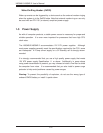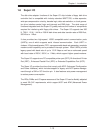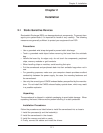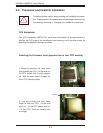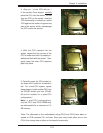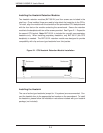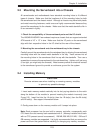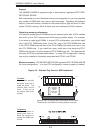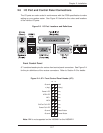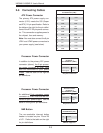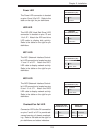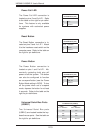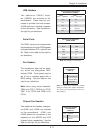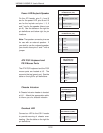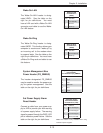
2-6
H8QM8-2/H8QME-2 User's Manual
Figure 2-2. Side and Top Views of DDR Installation
To Install:
Insert module vertically
and press down until it
snaps into place. The
release tabs should
close - if they do not
you should close them
yourself.
To Remove:
Use your thumbs to
gently push each re-
lease tab outward to
release the DIMM from
the slot.
Note: Notch
should align
with its
receptive point
on the slot
Notch
Notch
Release
Tab
Release
Tab
Note the notch in the slot and on the bottom of the DIMM.
These prevent the DIMM from being installed incorrectly.
Support
The H8QM8-2/H8QME-2 supports single or dual-channel, registered ECC DDR2-
667/533/400 SDRAM.
Both interleaved and non-interleaved memory are supported, so you may populate
any number of DIMM slots (see note on previous page). Populating two adjacent
slots at a time with memory modules of the same size and type will result in inter-
leaved (128-bit) memory, which is faster than non-interleaved (64-bit) memory.
Optimizing memory performance
It is better to spread pairs of DIMMs across all memory banks with a CPU installed
than to fi ll up one CPU memory bank while leaving another empty. For example,
if you were to install eight DIMMs in a quad-CPU confi guration, you should install
two in the CPU1 DIMM slots (slots 1A and 1B) , two in the CPU2 DIMM slots, two
in the CPU3 DIMM slots and two in the CPU4 DIMM slots rather than four in any
two CPU DIMM slots. If you install four more, install two in the remaining CPU1
DIMM slots and two in the the remaining CPU2 DIMM slots, etc. This balances the
load over all CPUs to optimize performance. In a dual-CPU confi guration, memory
can only be installed in the banks associated with CPU#1 and CPU#2.
Maximum memory: 128 GB DDR2-667/533/400 registered ECC SDRAM (256 GB
for 8-way confi guration). In a dual-CPU confi guration, memory support is halved.



